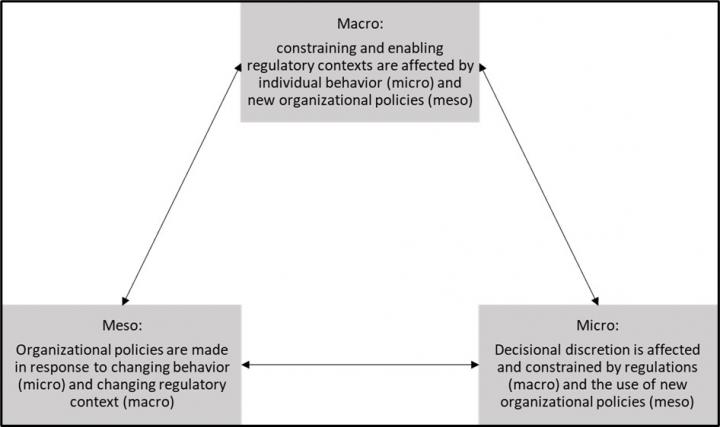The Canadian Science Policy Centre (CSPC) in a September 15, 2022 announcement (received via email) announced an event (Age of AI and Big Data – Impact on Justice, Human Rights and Privacy) centered on some of the latest government doings on artificial intelligence and privacy (Bill C-27),
In an increasingly connected world, we share a large amount of our data in our daily lives without our knowledge while browsing online, traveling, shopping, etc. More and more companies are collecting our data and using it to create algorithms or AI. The use of our data against us is becoming more and more common. The algorithms used may often be discriminatory against racial minorities and marginalized people.
As technology moves at a high pace, we have started to incorporate many of these technologies into our daily lives without understanding its consequences. These technologies have enormous impacts on our very own identity and collectively on civil society and democracy.
Recently, the Canadian Government introduced the Artificial Intelligence and Data Act (AIDA) and Bill C-27 [which includes three acts in total] in parliament regulating the use of AI in our society. In this panel, we will discuss how our AI and Big data is affecting us and its impact on society, and how the new regulations affect us.
Date: Sep 28 Time: 12:00 pm – 1:30 pm EDT Event Category: Virtual Session
For some reason, there was no information about the moderator and panelists, other than their names, titles, and affiliations. Here’s a bit more:
Moderator: Yuan Stevens (from her eponymous website’s About page), Note: Links have been removed,
Yuan (“You-anne”) Stevens (she/they) is a legal and policy expert focused on sociotechnical security and human rights.
She works towards a world where powerful actors—and the systems they build—are held accountable to the public, especially when it comes to marginalized communities.
She brings years of international experience to her role at the Leadership Lab at Toronto Metropolitan University [formerly Ryerson University], having examined the impacts of technology on vulnerable populations in Canada, the US and Germany.
Committed to publicly accessible legal and technical knowledge, Yuan has written for popular media outlets such as the Toronto Star and Ottawa Citizen and has been quoted in news stories by the New York Times, the CBC and the Globe & Mail.Yuan is a research fellow at the Centre for Law, Technology and Society at the University of Ottawa and a research affiliate at Data & Society Research Institute. She previously worked at Harvard University’s Berkman Klein Center for Internet & Society during her studies in law at McGill University.
She has been conducting research on artificial intelligence since 2017 and is currently exploring sociotechnical security as an LL.M candidate at University of Ottawa’s Faculty of Law working under Florian Martin-Bariteau.
Panelist: Brenda McPhail (from her Centre for International Governance Innovation profile page),
Brenda McPhail is the director of the Canadian Civil Liberties Association’s Privacy, Surveillance and Technology Project. Her recent work includes guiding the Canadian Civil Liberties Association’s interventions in key court cases that raise privacy issues, most recently at the Supreme Court of Canada in R v. Marakah and R v. Jones, which focused on privacy rights in sent text messages; research into surveillance of dissent, government information sharing, digital surveillance capabilities and privacy in relation to emergent technologies; and developing resources and presentations to drive public awareness about the importance of privacy as a social good.
Panelist: Nidhi Hegde (from her University of Alberta profile page),
My research has spanned many areas such as resource allocation in networking, smart grids, social information networks, machine learning. Broadly, my interest lies in gaining a fundamental understanding of a given system and the design of robust algorithms.
More recently my research focus has been in privacy in machine learning. I’m interested in understanding how robust machine learning methods are to perturbation, and privacy and fairness constraints, with the goal of designing practical algorithms that achieve privacy and fairness.
Bio
Before joining the University of Alberta, I spent many years in industry research labs. Most recently, I was a Research team lead at Borealis AI (a research institute at Royal Bank of Canada), where my team worked on privacy-preserving methods for machine learning models and other applied problems for RBC. Prior to that, I spent many years in research labs in Europe working on a variety of interesting and impactful problems. I was a researcher at Bell Labs, Nokia, in France from January 2015 to March 2018, where I led a new team focussed on Maths and Algorithms for Machine Learning in Networks and Systems, in the Maths and Algorithms group of Bell Labs. I also spent a few years at the Technicolor Paris Research Lab working on social network analysis, smart grids, and privacy in recommendations.
Panelist: Benjamin Faveri (from his LinkedIn page),
About
Benjamin Faveri is a Research and Policy Analyst at the Responsible AI Institute (RAII) [headquarted in Austin, Texas]. Currently, he is developing their Responsible AI Certification Program and leading it through Canada’s national accreditation process. Over the last several years, he has worked on numerous certification program-related research projects such as fishery economics and certification programs, police body-worn camera policy certification, and emerging AI certifications and assurance systems. Before his work at RAII, Benjamin completed a Master of Public Policy and Administration at Carleton University, where he was a Canada Graduate Scholar, Ontario Graduate Scholar, Social Innovation Fellow, and Visiting Scholar at UC Davis School of Law. He holds undergraduate degrees in criminology and psychology, finishing both with first class standing. Outside of work, Benjamin reads about how and why certification and private governance have been applied across various industries.
Panelist: Ori Freiman (from his eponymous website’s About page)
I research at the forefront of technological innovation. This website documents some of my academic activities.
My formal background is in Analytic Philosophy, Library and Information Science, and Science & Technology Studies. Until September 22′ [September 2022], I was a Post-Doctoral Fellow at the Ethics of AI Lab, at the University of Toronto’s Centre for Ethics. Before joining the Centre, I submitted my dissertation, about trust in technology, to The Graduate Program in Science, Technology and Society at Bar-Ilan University.
I have also found a number of overviews and bits of commentary about the Canadian federal government’s proposed Bill C-27, which I think of as an omnibus bill as it includes three proposed Acts.
The lawyers are excited but I’m starting with the Responsible AI Institute’s (RAII) response first as one of the panelists (Benjamin Faveri) works for them and it’s a view from a closely neighbouring country, from a June 22, 2022 RAII news release, Note: Links have been removed,
Business Implications of Canada’s Draft AI and Data Act
On June 16 [2022], the Government of Canada introduced the Artificial Intelligence and Data Act (AIDA), as part of the broader Digital Charter Implementation Act 2022 (Bill C-27). Shortly thereafter, it also launched the second phase of the Pan-Canadian Artificial Intelligence Strategy.
Both RAII’s Certification Program, which is currently under review by the Standards Council of Canada, and the proposed AIDA legislation adopt the same approach of gauging an AI system’s risk level in context; identifying, assessing, and mitigating risks both pre-deployment and on an ongoing basis; and pursuing objectives such as safety, fairness, consumer protection, and plain-language notification and explanation.
Businesses should monitor the progress of Bill C-27 and align their AI governance processes, policies, and controls to its requirements. Businesses participating in RAII’s Certification Program will already be aware of requirements, such as internal Algorithmic Impact Assessments to gauge risk level and Responsible AI Management Plans for each AI system, which include system documentation, mitigation measures, monitoring requirements, and internal approvals.
…
The AIDA draft is focused on the impact of any “high-impact system”. Companies would need to assess whether their AI systems are high-impact; identify, assess, and mitigate potential harms and biases flowing from high-impact systems; and “publish on a publicly available website a plain-language description of the system” if making a high-impact system available for use. The government elaborated in a press briefing that it will describe in future regulations the classes of AI systems that may have high impact.
The AIDA draft also outlines clear criminal penalties for entities which, in their AI efforts, possess or use unlawfully obtained personal information or knowingly make available for use an AI system that causes serious harm or defrauds the public and causes substantial economic loss to an individual.
If enacted, AIDA would establish the Office of the AI and Data Commissioner, to support Canada’s Minister of Innovation, Science and Economic Development, with powers to monitor company compliance with the AIDA, to order independent audits of companies’ AI activities, and to register compliance orders with courts. The Commissioner would also help the Minister ensure that standards for AI systems are aligned with international standards.
…
Apart from being aligned with the approach and requirements of Canada’s proposed AIDA legislation, RAII is also playing a key role in the Standards Council of Canada’s AI accreditation pilot. The second phase of the Pan-Canadian includes funding for the Standards Council of Canada to “advance the development and adoption of standards and a conformity assessment program related to AI/”
The AIDA’s introduction shows that while Canada is serious about governing AI systems, its approach to AI governance is flexible and designed to evolve as the landscape changes.
Charles Mandel’s June 16, 2022 article for Betakit (Canadian Startup News and Tech Innovation) provides an overview of the government’s overall approach to data privacy, AI, and more,
The federal Liberal government has taken another crack at legislating privacy with the introduction of Bill C-27 in the House of Commons.
Among the bill’s highlights are new protections for minors as well as Canada’s first law regulating the development and deployment of high-impact AI systems.
“It [Bill C-27] will address broader concerns that have been expressed since the tabling of a previous proposal, which did not become law,” a government official told a media technical briefing on the proposed legislation.
François-Philippe Champagne, the Minister of Innovation, Science and Industry, together with David Lametti, the Minister of Justice and Attorney General of Canada, introduced the Digital Charter Implementation Act, 2022. The ministers said Bill C-27 will significantly strengthen Canada’s private sector privacy law, create new rules for the responsible development and use of artificial intelligence (AI), and continue to put in place Canada’s Digital Charter.
The Digital Charter Implementation Act includes three proposed acts: the Consumer Privacy Protection Act, the Personal Information and Data Protection Tribunal Act, and the Artificial Intelligence and Data Act (AIDA)- all of which have implications for Canadian businesses.
Bill C-27 follows an attempt by the Liberals to introduce Bill C-11 in 2020. The latter was the federal government’s attempt to reform privacy laws in Canada, but it failed to gain passage in Parliament after the then-federal privacy commissioner criticized the bill.
The proposed Artificial Intelligence and Data Act is meant to protect Canadians by ensuring high-impact AI systems are developed and deployed in a way that identifies, assesses and mitigates the risks of harm and bias.
For businesses developing or implementing AI this means that the act will outline criminal prohibitions and penalties regarding the use of data obtained unlawfully for AI development or where the reckless deployment of AI poses serious harm and where there is fraudulent intent to cause substantial economic loss through its deployment.
..
An AI and data commissioner will support the minister of innovation, science, and industry in ensuring companies comply with the act. The commissioner will be responsible for monitoring company compliance, ordering third-party audits, and sharing information with other regulators and enforcers as appropriate.
The commissioner would also be expected to outline clear criminal prohibitions and penalties regarding the use of data obtained unlawfully for AI development or where the reckless deployment of AI poses serious harm and where there is fraudulent intent to cause substantial economic loss through its deployment.
…
Canada already collaborates on AI standards to some extent with a number of countries. Canada, France, and 13 other countries launched an international AI partnership to guide policy development and “responsible adoption” in 2020.
The federal government also has the Pan-Canadian Artificial Intelligence Strategy for which it committed an additional $443.8 million over 10 years in Budget 2021. Ahead of the 2022 budget, Trudeau [Canadian Prime Minister Justin Trudeau] had laid out an extensive list of priorities for the innovation sector, including tasking Champagne with launching or expanding national strategy on AI, among other things.
Within the AI community, companies and groups have been looking at AI ethics for some time. Scotiabank donated $750,000 in funding to the University of Ottawa in 2020 to launch a new initiative to identify solutions to issues related to ethical AI and technology development. And Richard Zemel, co-founder of the Vector Institute [formed as part of the Pan-Canadian Artificial Intelligence Strategy], joined Integrate.AI as an advisor in 2018 to help the startup explore privacy and fairness in AI.
When it comes to the Consumer Privacy Protection Act, the Liberals said the proposed act responds to feedback received on the proposed legislation, and is meant to ensure that the privacy of Canadians will be protected, and that businesses can benefit from clear rules as technology continues to evolve.
“A reformed privacy law will establish special status for the information of minors so that they receive heightened protection under the new law,” a federal government spokesperson told the technical briefing.
..
The act is meant to provide greater controls over Canadians’ personal information, including how it is handled by organizations as well as giving Canadians the freedom to move their information from one organization to another in a secure manner.
The act puts the onus on organizations to develop and maintain a privacy management program that includes the policies, practices and procedures put in place to fulfill obligations under the act. That includes the protection of personal information, how requests for information and complaints are received and dealt with, and the development of materials to explain an organization’s policies and procedures.
The bill also ensures that Canadians can request that their information be deleted from organizations.
The bill provides the privacy commissioner of Canada with broad powers, including the ability to order a company to stop collecting data or using personal information. The commissioner will be able to levy significant fines for non-compliant organizations—with fines of up to five percent of global revenue or $25 million, whichever is greater, for the most serious offences.
The proposed Personal Information and Data Protection Tribunal Act will create a new tribunal to enforce the Consumer Privacy Protection Act.
Although the Liberal government said it engaged with stakeholders for Bill C-27, the Council of Canadian Innovators (CCI) expressed reservations about the process. Nick Schiavo, CCI’s director of federal affairs, said it had concerns over the last version of privacy legislation, and had hoped to present those concerns when the bill was studied at committee, but the previous bill died before that could happen.
…
Now the lawyers. Simon Hodgett, Kuljit Bhogal, and Sam Ip have written a June 27, 2022 overview, which highlights the key features from the perspective of Osler, a leading business law firm practising internationally from offices across Canada and in New York.
Maya Medeiros and Jesse Beatson authored a June 23, 2022 article for Norton Rose Fulbright, a global law firm, which notes a few ‘weak’ spots in the proposed legislation,
…
… While the AIDA is directed to “high-impact” systems and prohibits “material harm,” these and other key terms are not yet defined. Further, the quantum of administrative penalties will be fixed only upon the issuance of regulations.
Moreover, the AIDA sets out publication requirements but it is unclear if there will be a public register of high-impact AI systems and what level of technical detail about the AI systems will be available to the public. More clarity should come through Bill C-27’s second and third readings in the House of Commons, and subsequent regulations if the bill passes.
The AIDA may have extraterritorial application if components of global AI systems are used, developed, designed or managed in Canada. The European Union recently introduced its Artificial Intelligence Act, which also has some extraterritorial application. Other countries will likely follow. Multi-national companies should develop a coordinated global compliance program.
…
I have two podcasts from Michael Geist, a lawyer and Canada Research Chair in Internet and E-Commerce Law at the University of Ottawa.
- June 26, 2022: The Law Bytes Podcast, Episode 132: Ryan Black on the Government’s Latest Attempt at Privacy Law Reform “The privacy reform bill that is really three bills in one: a reform of PIPEDA, a bill to create a new privacy tribunal, and an artificial intelligence regulation bill. What’s in the bill from a privacy perspective and what’s changed? Is this bill any likelier to become law than an earlier bill that failed to even advance to committee hearings? To help sort through the privacy aspects of Bill C-27, Ryan Black, a Vancouver-based partner with the law firm DLA Piper (Canada) …” (about 45 mins.)
- August 15, 2022: The Law Bytes Podcast, Episode 139: Florian Martin-Bariteau on the Artificial Intelligence and Data Act “Critics argue that regulations are long overdue, but have expressed concern about how much of the substance is left for regulations that are still to be developed. Florian Martin-Bariteau is a friend and colleague at the University of Ottawa, where he holds the University Research Chair in Technology and Society and serves as director of the Centre for Law, Technology and Society. He is currently a fellow at the Harvard’s Berkman Klein Center for Internet and Society …” (about 38 mins.)





